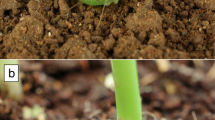Abstract
Butting behavior of a bamboo horned aphid,Astegopteryx bambucifoliae, is described. A walking aphid becomes an attacker, who butts, with its frontal horns, a stationary aphid inserting the stylets in the plant tissue. An attacker usually butts up a sufferer without clasping it at first, and then clasps the sufferer with the forelegs and butts it. When butted up, the sufferer lowers the attacked side, or it rotates, keeping the stylets in the plant tissue, so as to face toward the attacker. When clasped and butted from the front, the sufferer raises its abdoment at an angle of 30–90°. Often, the sufferer's abdomen is raised at an angle of more than 90°, with the tip bent forward, so that the hindlegs are detached from the plant surface; the sufferer pushes the attacker's head with its back. The butting results in either that the attacker ceases butting and goes away, or that the attacker drives the sufferer away. Having succeeded in driving a sufferer away, the attacker probes, with its rostrum, about the place where the sufferer's mouthparts were located. Thereafter, the attacker usually starts feeding there.
Similar content being viewed by others
References
Aoki, S., S. Akimoto & Sk. Yamane 1981 Observations onPseudoregma alexanderi (Homoptera, Pemphigidae), an aphid species producing pseudoscorpion-like soldiers on bamboos.Kontyû 49: 355–366.
Aoki, S., U. Kurosu & S. Usuba 1984 First instar larvae of the sugar-cane wooly aphid.Ceratovacuna lanigera (Homoptera, Pemphigidae), attack its predators.Kontyû 52: 458–460.
Aoki, S. & M. Miyazaki 1978 Notes on the pseudoscorpion-like larvae ofPseudoregma alexanderi (Homoptera, Aphidoidea).Kontyû 46: 433–438.
Blackman, R. L. & V. F. Eastop 1984 Aphids on the world's crops: an identification and information guid. John Wiley & Sons, Chichester. 466 pp.
Hamilton, W. D. 1964 The genetical evolution of social behaviour, I & II.J. theoret. Biol. 7: 1–52.
Hamilton, W. D. 1971 Selection of selfish and altruistic behavior in some extreme models. In: J. F. Eisenberg & W. S. Dillon (eds.)Man and beast: comparative social behavior. pp. 57–91. Smithonian Institution Press, Washington, DC.
Hille Ris Lambers, D. 1953 Notes on aphids fromCocos nucifera.Agric. J. Fiji 24 (3 & 4): 1–3.
Liao, H.-T. 1976 Bamboo aphids of Taiwan.Quart. J. Taiwan Mus. 29: 499–586.
Takahashi, R. 1923 Aphididae of Formosa, II.Dept. Agr. Govt. Res. Inst. Formosa, Rept. no.4: 1–173.
Takahashi, R. 1924 Aphididae of Formosa, III.Dept. Agr. Govt. Res. Inst. Formosa, Rept. no.10: 1–121.
Author information
Authors and Affiliations
About this article
Cite this article
Aoki, S., Kurosu, U. An aphid species doing a headstand: Butting behavior ofAstegopteryx bambucifoliae (Homoptera: Aphidoidea). J. Ethol. 3, 83–87 (1985). https://doi.org/10.1007/BF02350297
Received:
Accepted:
Issue Date:
DOI: https://doi.org/10.1007/BF02350297




